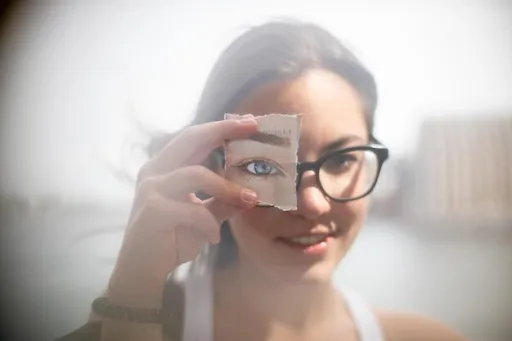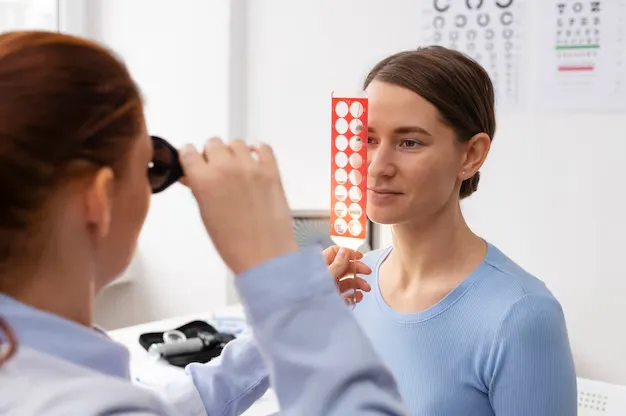Tear Film and Vision
The Role of Tear Film in Maintaining Healthy Vision
FSDAVCFEBFEVSDDVFSD
FSDAVCFEBFEVSDDVFSD
FSDAVCFEBFEVSDDVFSD
What Is the Tear Film?
The tear film is a thin, protective layer of moisture that coats the surface of the eyes. It plays a crucial role in maintaining clear vision and overall eye health. Made up of three distinct layers lipid (oil), aqueous (water), and mucin (mucus) the tear film keeps the eyes hydrated, nourishes the cornea, and provides a smooth refractive surface for optimal vision.
When the tear film functions properly, it prevents irritation, minimizes friction when blinking, and removes debris that could harm the eye. However, if this delicate balance is disrupted, it can lead to discomfort, dryness, and even vision issues, highlighting the importance of maintaining a stable tear film.
The tear film is a thin, protective layer of moisture that coats the surface of the eyes. It plays a crucial role in maintaining clear vision and overall eye health. Made up of three distinct layers lipid (oil), aqueous (water), and mucin (mucus) the tear film keeps the eyes hydrated, nourishes the cornea, and provides a smooth refractive surface for optimal vision.

When the tear film functions properly, it prevents irritation, minimizes friction when blinking, and removes debris that could harm the eye. However, if this delicate balance is disrupted, it can lead to discomfort, dryness, and even vision issues, highlighting the importance of maintaining a stable tear film.

Causes of Tear Film Imbalance
Tear film stability is crucial for maintaining eye comfort and health. However, several factors can disrupt this delicate balance, leading to dry eye symptoms. Environmental conditions such as wind, smoke, and air conditioning can speed up tear evaporation, leaving the eyes feeling dry and irritated. Prolonged screen time also plays a significant role by reducing blinking frequency, causing the tear film to break down faster and increasing discomfort.
Aging is another common contributor to tear film instability. As we age, natural tear production decreases, leading to dryness and irritation. Hormonal changes, particularly in women during pregnancy, menopause, or other life stages, can also alter tear composition, making the eyes more susceptible to dryness. These fluctuations often highlight the need for specialized care to maintain tear film balance.
Certain medical conditions can further exacerbate tear film dysfunction. Autoimmune diseases, diabetes, and medications like antihistamines or antidepressants may interfere with normal tear production and quality. By understanding these contributing factors, individuals can take proactive steps to manage and prevent tear film-related issues. Regular eye exams and tailored treatments, such as artificial tears or lifestyle adjustments, can help restore comfort and maintain optimal eye health.
Symptoms of Tear Film Dysfunction

Tear film imbalances can cause a range of uncomfortable symptoms, including dryness, burning, and fluctuating vision. Many individuals report experiencing a gritty or sandy sensation in their eyes, accompanied by redness and irritation. Sensitivity to light and blurred vision that temporarily improves with blinking are also common signs of tear film instability. These symptoms can significantly impact daily activities, especially those involving prolonged screen use or exposure to dry environments.

If left untreated, chronic tear film instability can progress into more severe dry eye syndrome, which may cause persistent discomfort and difficulty focusing. Additionally, an unstable tear film increases the risk of eye infections, as tears play a vital role in protecting the eyes from harmful microorganisms. Seeking prompt evaluation and treatment from an eye care professional is essential to address these symptoms and prevent long-term complications.
Maintaining a healthy tear film is crucial for ensuring long-term eye comfort and visual clarity. The tear film, a delicate balance of water, oils, and mucus, not only keeps the eyes lubricated but also protects them from environmental irritants and infections. A stable tear film is essential for smooth, clear vision, as it allows light to pass evenly through the eye without distortion. However, factors such as prolonged screen time, exposure to dry or windy environments, aging, and hormonal changes can disrupt this balance, leading to symptoms like dryness, irritation, and blurry vision.
To support a healthy tear film, it’s important to adopt preventive measures and seek treatment when necessary. Simple lifestyle changes, such as staying hydrated, using a humidifier, and taking regular breaks from screens, can significantly improve tear film stability. Additionally, wearing protective eyewear outdoors and consuming omega-3-rich foods can enhance tear production and quality. For those experiencing persistent symptoms, lubricating eye drops or specialized treatments prescribed by an eye care professional can provide relief and restore balance. Prioritizing tear film health not only enhances daily comfort but also safeguards your vision for the future.
How to Support a Healthy Tear Film
Maintaining a balanced tear film is essential for eye comfort and clarity, and it starts with simple lifestyle adjustments. Regular blinking helps distribute tears evenly across the eye’s surface, preventing dryness and irritation, especially during prolonged screen use. Staying hydrated supports natural tear production, while over-the-counter artificial tears can replenish moisture when needed. Following the 20-20-20 rule, taking a 20-second break to look at something 20 feet away every 20 minutes can also reduce eye strain from screens, helping to preserve tear film stability.
For persistent or severe symptoms, professional care is crucial. An eye doctor can evaluate the root cause of tear film imbalances and recommend advanced treatments tailored to individual needs. These may include prescription eye drops to improve tear quality, or in-office therapies designed to address underlying conditions like meibomian gland dysfunction. Combining proactive lifestyle changes with expert guidance ensures optimal tear film health and long-term eye comfort.
Treatment Options for Tear Film Imbalance
If lifestyle adjustments and artificial tears do not sufficiently address dry eye symptoms, additional treatments can help restore tear film stability and improve comfort. One option is prescription eye drops like cyclosporine (Restasis) or lifitegrast (Xiidra), which reduce inflammation and enhance natural tear production. These medications target the root cause of dry eye for long-term relief.
For patients needing additional support, punctal plugs offer a simple yet effective solution.
If lifestyle adjustments and artificial tears do not sufficiently address dry eye symptoms, additional treatments can help restore tear film stability and improve comfort. One option is prescription eye drops like cyclosporine (Restasis) or lifitegrast (Xiidra), which reduce inflammation and enhance natural tear production. These medications target the root cause of dry eye for long-term relief.
For patients needing additional support, punctal plugs offer a simple yet effective solution. These tiny plugs are inserted into the tear ducts to slow tear drainage, helping to retain moisture on the eye surface for longer durations. This approach is particularly beneficial for those with severe tear deficiency.

Advanced therapies such as LipiFlow® provide in-office solutions for addressing blocked meibomian glands. By restoring proper oil production, LipiFlow reduces tear evaporation and enhances overall tear film quality, ensuring sustained eye comfort.

These tiny plugs are inserted into the tear ducts to slow tear drainage, helping to retain moisture on the eye surface for longer durations. This approach is particularly beneficial for those with severe tear deficiency.
Advanced therapies such as LipiFlow® provide in-office solutions for addressing blocked meibomian glands. By restoring proper oil production, LipiFlow reduces tear evaporation and enhances overall tear film quality, ensuring sustained eye comfort.
When to See an Eye Doctor for Dry Eyes
If dry eye symptoms persist despite efforts like using artificial tears or adjusting your lifestyle, it’s important to seek professional care. Persistent dryness, irritation, or fluctuating vision can indicate deeper issues with your tear film or other underlying conditions that require medical attention. A comprehensive eye exam allows an optometrist to assess tear production, evaluate the quality of your tear film, and determine the root cause of your discomfort.
During the exam, your eye doctor may perform specialized tests to measure tear volume, stability, and evaporation rates. They might also check for inflammation, gland dysfunction, or structural issues contributing to your symptoms. By identifying these factors, the optometrist can provide a personalized treatment plan tailored to your specific needs.
Treatment options may include prescription eye drops, punctal plugs to retain natural tears, or advanced therapies like LipiFlow® for improving the oil layer of the tear film. These approaches target the root causes of dry eye, offering long-term relief and protection against complications like corneal damage or chronic discomfort. Regular follow-ups ensure that treatments remain effective and adapt to changing needs.
Scheduling an eye exam for dry eye relief is an essential step in preventing long-term complications and improving your daily comfort. With expert guidance, you can restore tear film balance, protect your vision, and enjoy lasting relief from the frustrating symptoms of dry eye syndrome. Prioritizing professional care ensures not only clearer vision but also enhanced quality of life.
The Link Between Tear Film and Vision Clarity
A stable tear film is crucial for maintaining sharp and clear vision. Tears form a smooth optical layer over the cornea, allowing light to focus accurately on the retina. When the tear film becomes unstable, it can disrupt this process, leading to blurry or fluctuating vision throughout the day.


A stable tear film is crucial for maintaining sharp and clear vision. Tears form a smooth optical layer over the cornea, allowing light to focus accurately on the retina. When the tear film becomes unstable, it can disrupt this process, leading to blurry or fluctuating vision throughout the day.
Chronic tear film instability often affects individuals during activities requiring sustained focus, such as reading, driving, or using digital devices. These tasks can exacerbate symptoms, making it challenging to maintain consistent eyesight. Additionally, environmental factors like dry air or prolonged screen time can further destabilize the tear film, intensifying the discomfort.
Chronic tear film instability often affects individuals during activities requiring sustained focus, such as reading, driving, or using digital devices. These tasks can exacerbate symptoms, making it challenging to maintain consistent eyesight. Additionally, environmental factors like dry air or prolonged screen time can further destabilize the tear film, intensifying the discomfort.
Fortunately, appropriate treatments can help restore tear film balance and improve visual clarity. Options such as artificial tears, prescription eye drops, or advanced therapies like LipiFlow® address the root causes of tear film dysfunction. With proper care, individuals can enjoy consistent, comfortable vision and enhanced quality of life.
Fortunately, appropriate treatments can help restore tear film balance and improve visual clarity. Options such as artificial tears, prescription eye drops, or advanced therapies like LipiFlow® address the root causes of tear film dysfunction. With proper care, individuals can enjoy consistent, comfortable vision and enhanced quality of life.
Protecting Tear Film Health for the Future
Consistently prioritizing eye health is essential to prevent tear film imbalances from worsening over time. Regular comprehensive eye exams enable eye care professionals to assess tear quality and identify potential issues early. Early intervention can help address minor imbalances before they lead to more significant discomfort or vision problems, ensuring long-term eye health and comfort.
If you experience persistent dryness, irritation, or blurry vision, it’s important to seek professional advice. An eye exam can uncover the root cause of your symptoms and allow your doctor to recommend personalized solutions, such as artificial tears, prescription drops, or advanced therapies. Taking proactive steps to maintain a stable tear film not only enhances visual clarity but also improves your overall quality of life by reducing the discomfort associated with chronic dry eye symptoms. Contact us to schedule your eye exam today to safeguard your vision.

Contact Info
Hours of Operation
Mon - Fri | 9:00 AM - 5:00 PM
Sat - Sun | Closed
Holiday Hours: We are closed for the following holidays: New Years Day, Memorial Day, Independence Day, Labor Day, Thanksgiving Day, Christmas Day
© 2025 Kleinwood Vision. All rights Reserved.


